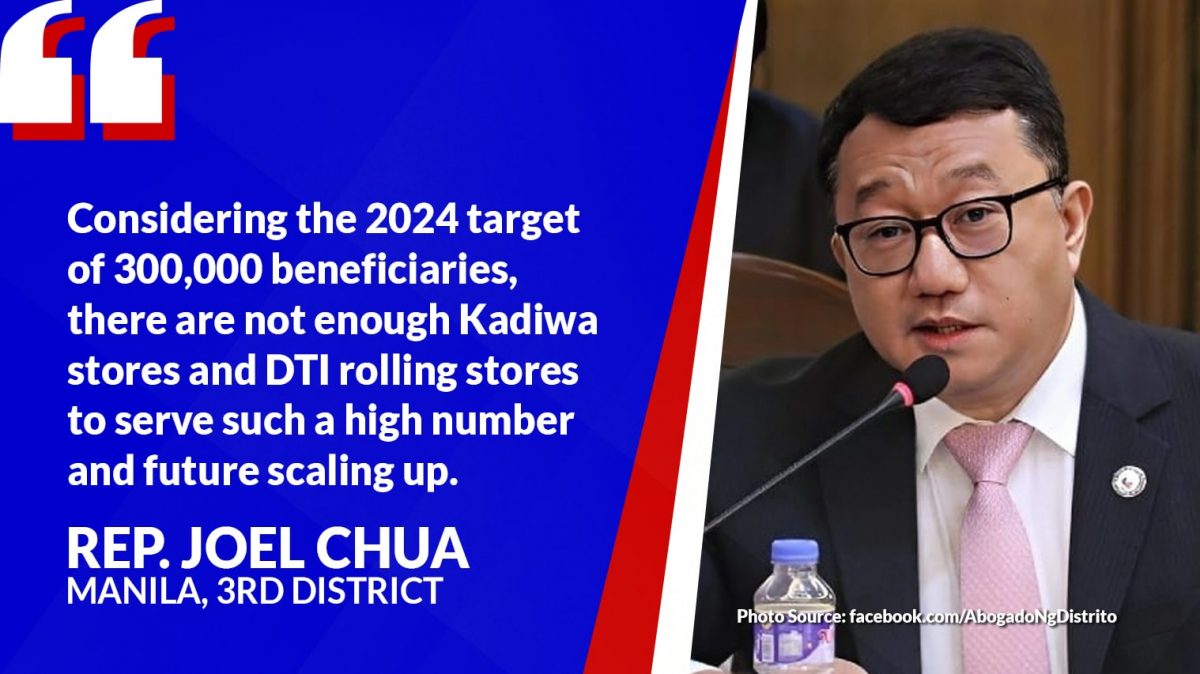Following the assignment of flagship status to the Food Stamp Program, Manila Third District Representative Joel Chua suggested to the Department of Social Welfare and Development that the electronic benefits transfer (EBT) card “should be usable at point-of-sale at supermarkets, groceries, and drugstores with electronic card readers, in addition to the Kadiwa stores and DTI rolling stores.”
“Considering the 2024 target of 300,000 beneficiaries, there are not enough Kadiwa stores and DTI rolling stores to serve such a high number and future scaling up,” Chua, a member of the House Committee on Poverty Alleviation, said.
“Instead of spending to build more of these government stores, it is much less costly to accredit and involve already established supermarkets, groceries, and drugstores for EBT rollout.”
The legislator added it is “too costly to build and deploy more Kadiwa and DTI stores. Instead of spending to build more of these government stores, it is much less costly to accredit and involve already established supermarkets, groceries, and drugstores for EBT rollout.”
The lawmaker suggested that EBT cards must be configured so they can be as portable as debit purchase cards and usable at electronically and internet-connected retail outlets.
“The EBT cards should be more portable than the Pantawid Pasada cards.”
“The EBT cards should be more portable than the Pantawid Pasada cards—the use of which is limited only to a few gasoline stations,” he stressed.
According to Chua, the current purchase limits and conditions of the EBT would be extremely difficult to administratively impose on the supermarkets, groceries, and drugstores.
“The retailers’ cashiers and personnel should not be burdened with the role of spending gatekeeper, which can be done only at the Kadiwa and DTI stores,” he said.
“To make the EBT more portable, the purchase conditions ought to be removed. Instead of these conditions and to have an assurance of prudence in budgeting EBT purchases, the EBT card should be in the name of the mother or suitable alternate if the beneficiary household has no mother, spouse, or common-law wife,” Chua recommended.
“A suitable alternative would be the grandmother in the household or the eldest child who is already of responsible age of 15 or older. Age 15 is the threshold age to be considered part of the labor force and employable,” he added.
Chua further suggests that for post-purchase monitoring, there should be some technological ways for the DSWD EBT project office to be electronically-tagged and send online electronic copies of purchases made using each EBT card.
“This should be part of the instructions and configuration of each EBT card. This way, DSWD will know whether each EBT card holder is responsibly using the EBT card,” he stressed.
“Beyond 2024, the scope of the EBT card program could include all 4Ps and AICS beneficiaries, as well as indigent seniors, PWDs, solo parents, and persons with special needs. This wider coverage would plug many leakages and inefficiencies in the current operations of the 4Ps and other ‘ayuda’ programs of the national government,” Chua proposed.


